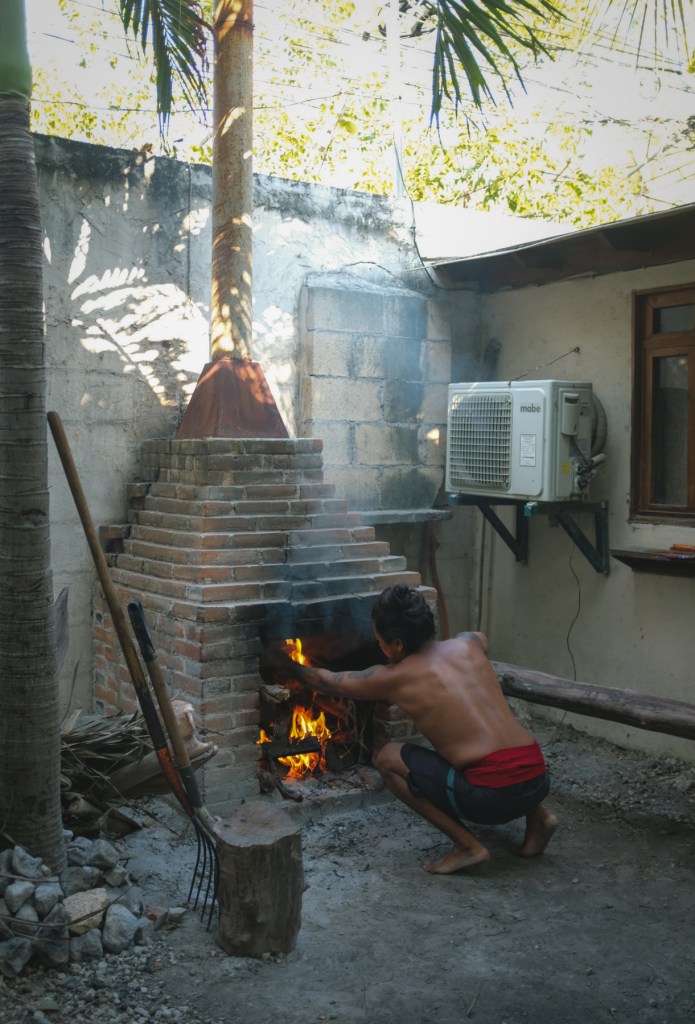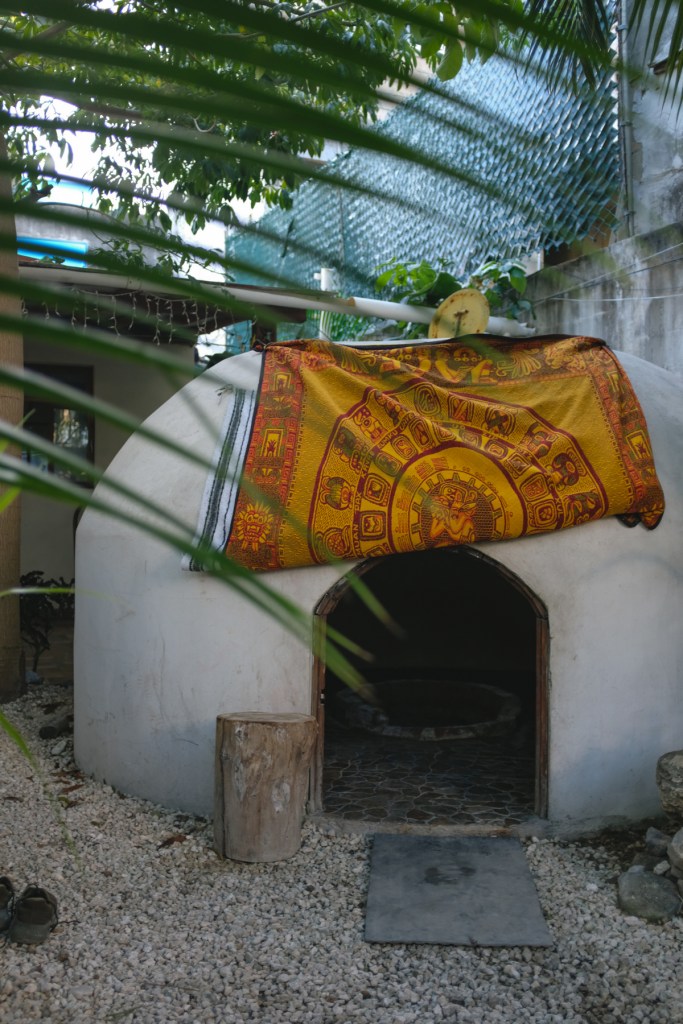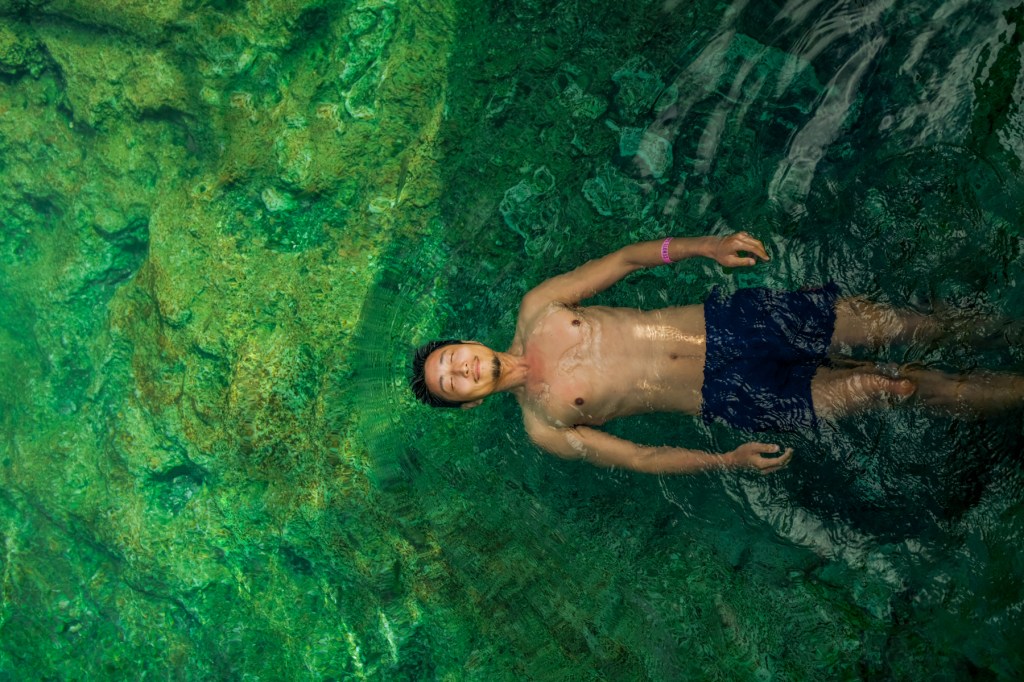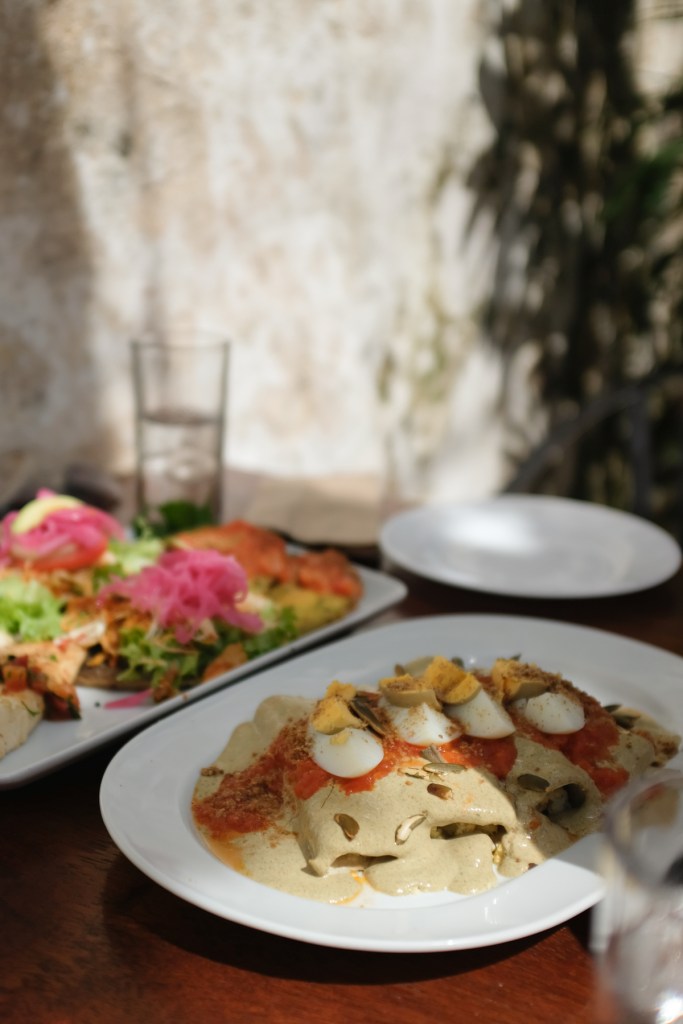Almost naked, we lay on our hearts against the quenching surface of the stone floor. Our chests expanded, expired, and gasped for air. Gliding over cooling puddles of sweat and condensed steam, the feather-damp brush of your arm felt like the first touch of life. There we were, the eight of us, teetering between a state of bliss and certain dehydration, arranged from head to toe in a circle around a hissing pit of volcanic rocks, which, only moments ago, cracked cosmic sparks before our eyes in the void. As our Big Bang came to an end, Will, the shaman, drew aside the blanket, opening the portal back into the dim residential streets of Playa del Carmen.
In between the drumming, chanting, and invocations of pre-Hispanic Aztec deities, our interpreter, Susana, explained the ceremonial aspects of the temazcal, the Mesoamerican steam bath, where, for an hour and a half, we sweated out everything but our souls. “For our ancestors, the half-moon of the temazcal represented the womb of the mother,” she said, her nightingale voice soaring into swirls of vapor. “Each emergence is therefore a spiritual passage, from the underworld into the realm of the living.”



Temazcales have existed across Mexico for more than a thousand years, long before the first Europeans laid eyes on this part of the world. The Maya of the Yucatan Peninsula called this type of bath zumpul-ché, while the Aztecs of central Mexico named theirs temāzcalli, derived from the Classical Nahuatl words tēma, meaning “bathing,” and calli, meaning “house.” In these ancient sweat lodges, superheated stones were anointed with fragrant herbs and doused with water to conjure a sacred space for physical and spiritual purification. Following the arrival of Spanish Catholics to Mexico in the 1500s, colonial governments almost extinguished the custom. The temazcales were seen as breeding grounds for carnal sin, including same-sex relations between men. Hundred of years later, these bathhouses are making a chaste comeback, shouldered by the efforts of Mexicans seeking to salvage their indigenous roots and tourists fixated on finding an “authentic experience.”
Whether or not it was truly like the temazcales of precolonial Mesoamerica, our three-hour ritual gave us the reset we sorely needed. Almost a week had passed since we touched down in Mexico, and our arrival in Cancun was starting to feel like a drawn-out Las Vegas hangover. From a bird’s-eye view, the 20-kilometer Zona Hotelera—a slithering figure-seven hotel strip running between the murky Nichupté Lagoon and the Caribbean Sea—looked paradisiacal. But as the great white jaws of Boulevard Kukulcán enveloped our timid little rental, we became surrounded by a swill of endless hotels, shopping centers, restaurants, and bars. Already in my adolescence, Cancun was a hub for spring breakers looking for a boozy good time. I just didn’t realize that mass tourism was its raison d’être.



There are vestiges of a Mayan civilization located in Cancun’s Zona Hotelera, but its original inhabitants disappeared ages before construction on the modern-day city broke ground. Founded in the early 1970s as a federal tourism project, the Mexican government had always been candid about Cancun. The city was born to be a moneymaker. Its sole purpose? To capture the growing number of US tourists visiting the Caribbean. To that end, the investment paid off swimmingly. It took less than twenty years to transform Cancun from an uninhabited jungle island into Mexico’s fiesta capital. Amidst a raucous sea of all-inclusives, we retreated into our sanctuary. Behind the soothing apricot walls of family-run Casa Tortugas, we quietly prepared our getaway out of “Gringolandia.” Even if it lies in Mexico, Cancun was annexed by America long ago.
The rise of Cancun lifted the entire Yucatan Peninsula out of obscurity. Until the 1960s, this region, now mainly divided between two Mexican states—Quintana Roo and Yucatán—was considered Central America’s wildest frontier. It was home to a rebellious indigenous population so hostile to the central Mexican government that any non-native who ventured into the area risked his life. Since then, the fishing villages and balmy islands along the Peninsula’s eastern coastline have developed into major tourism hotspots, eagerly welcoming anyone with a peso or dollar to spend. On Isla Mujeres, the coral sands and crystal waters of Playa Norte are known to be some of Mexico’s finest. Further south along the Mesoamerican Reef is Cozumel, an island famous for its cruise ships, mythical dives, and rich marine diversity. And then there’s Tulum, the bourgeois-bohemian beach town succumbed to its own success, surviving on the tales of those who traveled to the ancient Mayan port in its heyday, when its vine-draped ruins and uncouth beaches could still cover soul-searchers serenading each other in secret.




Our days driving along the Riviera Maya had the unshakable feeling of a simulation. In the interminable flatness of the Peninsula’s plains, we found ourselves rolling down an uncanny valley. All around us were the shells of an ancient, dead, and gorgeous universe. From Cancun to Tulum, the coastal towns formed a singular, artificial hive that masqueraded under the name of ecotourism. From the manscaped underground rivers of Xcaret to Akumal’s crooked turtle beach, everything was calculated, pre-packaged, and priced for consumption. The taste of brazen marketing campaigns and pushy roadside promoters stuck on our tongues like a stale Michelada, made on a beach bar massacred by motivational signs.
Even the region’s acclaimed cenotes—light-loving lagoons of greens and blues—are privatized behind admission counters. More well-known ones, such as the Gran Cenote and Cenote Zacil-Ha, have been beautified by fake stucco stelae, palm trees, rope swings, and Mayan statues. Others, like the obscure Cenote X’ux Ha, have been left mostly untouched. Brooding and mysterious, they lie underground, exposed to the surface above through only a rounded hole in the limestone ceiling.




From small clay pots, we delicately sipped our freshly brewed café de olla over a vibrantly Mexican dining table. The smell of cinnamon and cloves evoked images of autumn, a season which has never graced Rancho la Cachimba, a roadside eatery in the pueblo of Macario Gómez, just outside of Tulum. It was our second morning here, and we relished the easygoingness. In the background, dusty piñatas shimmied their draping tinsels. From the loudspeakers, Natalia Lafourcade sang us softly awake. Most cachimbas are rather inconspicuous, our camarero explained as he brought over breakfast. They were simple shacks of metal and wood, found mostly by the side of highways, where toiling truck drivers could stop for the night and enjoy a hot meal, a warm bed, and on occasion, a woman’s caress. It was—like the flavors we tucked into—a completely unfamiliar world. In between bites of chilaquiles, or salsa-drenched tortillas, and huevos motuleños, a regional egg dish served with fried plantains, we pried for more glimpses into local life: habits, favorite cenotes…
“The cenotes are mainly for tourists,” he answered with a bashful smile. As it turned out, the deep groundwater sinkholes are seldom visited by real residents. The ever-increasing price of entry prevents them from going on even a semi-regular basis. It didn’t used to be this way. The ancient Maya considered the dzonot—later hispanicized as cenote—sacred, and some of them were used as drinking sources. The gritty realization that those who live here cannot benefit from their purest and most splendid natural resource was a bitter truth to swallow.
Turning our backs on the Riviera, we drove into the thick of the jungle, stopping briefly by the tranquil Laguna Cobá, where one of the most powerful Mayan city-states on the peninsula once stood. On the austerely elegant grounds of Coqui Coqui, we refreshed our senses in blends of unique aromas—agave, coconut, tobacco—a last dab of luxury before crossing the state border out of Quintana Roo and into Yucatán.





Traces of ancient Mayan civilizations are scattered all around the Yucatan Peninsula, buried beneath a vast canopy of thick olive-green bush. Towering above them all is Chichen Itza. Named one of the New Seven Wonders of the World, this pre-Columbian city has gripped the public attention and imagination for more than a century. While thousands of visitors flock to see its iconic step-pyramid each day, in its shadow, quieter sites like Ek’ Balam still give an impression of being undiscovered. One cloudless midmorning, we found ourselves almost alone, next to deserted temples decorated by serpent heads, winged warriors, and cryptic glyphs.
As mystical as they are, these archaeological ruins are a modern point of contention between autochthon and authority, a strained legacy of the Peninsula’s embittered history and struggle against colonization. On the second day of the new year, the roads leading to Chichen Itza were blocked by Mayan protesters rallying for the removal of the site’s director on grounds of injustice and mistreatment. Accusations abounded of INAH, Mexico’s National Institute of Anthropology and History, prohibiting vendors from conversing in Maya, limiting the number of souvenir stalls onsite, and forbidding farmers from planting on their own land or repurposing them as parking lots for tourists.
The blockade of Chichen Itza was lifted after ten days, but its effects spilled over into neighboring areas. In February, the owners of the lands surrounding Ek’ Balam began to demand a parking fee almost a kilometer outside the entry of the archaeological zone, citing that the road to the ruins was situated on private land and that the expiration of a previous agreement with the government now authorized them to charge for parking. In the thinly woven explanation, one thing was transparent: money from tourism rarely made it into the pockets of local communities. Even at the official level, a feeling of discord hangs in the air. A visit of either Chichen Itza or Ek’ Balam, for example, requires the purchase of two separate tickets for the same attraction. One payment went to the federal INAH, another went to the state-run Ministry of Culture.





Compared to the elaborate and fanciful masks of the Mayan temples, the religious architecture of Valladolid feels rigid, softened only by the floral pastel façades of the flourishing Calzada de los Frailes. The small street is home to an array of designer boutiques, a hip mezcalería, and possibly the most mouthwatering ceviche inland of the Caribbean. During its first incarnation in the 16th century, it was a sacbe—Maya for “white road”—which connected the walled Spanish colony to the indigenous town of Ziiz-Ha, literally “cold water,” now Valladolid’s Sisal district. At the end of this white road stands the former Convent of San Bernardino de Siena, an imposing Franciscan edifice previously used for the Christianization of the Maya.
Early colonial expansion and missionary efforts went hand-in-hand, with the church acting as a religious arm of the imperial government. Spain, in particular, prioritized the conversion of the native people. Over the years, Catholic missionaries who initially appeared as models of virtue became aggressive, resorting to violence and torture to quash out traditional Mesoamerican customs they deemed idolatrous, from temazcales to ritual bloodletting and human sacrifice. Their evangelism was a success; like the rest of Mexico, the Yucatan Peninsula became predominantly Catholic. However, centuries of abuse gave birth to a collective indigenous resentment that would eventually set the scene for two pivotal events in Mexico’s history: the Caste War of Yucatán, which began in 1847 and lasted for more than 50 years; and the Mexican Revolution, sparked by a rebellion right in Valladolid. In the years that followed, colonial towns like Valladolid and the sunburst-yellow Izamal have softened their image. Both belong to Mexico’s Pueblos Magicos—a list of a hundred or so towns recognized by the federal Ministry of Tourism for their magical qualities and folkloric heritage.




On the Peninsula’s north coast, sheltered from the Gulf of Mexico by a belt of mangrove forest, is Río Lagartos. This modest fisherman’s village has only a handful of streets. It’s harder to tell whether there are fewer hotels or fewer restaurants here, which speaks volumes about its rank on the list of Yucatan attractions. In the lack of things to do is a priceless serenity; we had stumbled upon an oasis. Free from the heavy itinerary of cenotes, pyramids, admission tickets, parking fees, and suspicious police, we were unbothered and unburdened. Perhaps Río Lagartos is what Tulum used to feel like.
Most of the income generated from tourism in Río Lagartos comes from a single activity: a boat tour across the Ría Lagartos Biosphere Reserve. On the docks, skippers like Ramón chatter and wait in a casual queuing system for the chance to take visitors around the biosphere. The tropical wetlands encompass an area so vast, its first settlers mistook the lagoon for a river, giving it the name Río Lagartos, or “alligator river.” In addition to the crocodiles, ospreys, and raccoons that make their home here, the reserve is one of two places on the peninsula where flamingos are found. These flamboyant wading birds can be spotted year-round, feeding off algae and minuscule crustaceans in the rose-quartz waters of Las Coloradas’ salt pans. Next to their shores, the mixture of brine and minerals forms a slippery slush, which Ramón gestured for us to lather onto ourselves. “Maya mud bath,” he said, swiping up a handful of the goop. A convivial gentleman with a round face and eyes that smiled with the calmness of age, Ramón reminded me of my grandfather. Perhaps it was this detail which made me listen and oblige.






The sun was high overhead by the time we returned to the docks. Ramón suggested us to dine at the restaurant across the street. Under a palm-thatched roof, we shared platters of conch ceviche and buttered spiny lobster—two local delicacies plucked straight from the sea. Shamelessly, I licked clean all of the piquant Tajín seasoning from the rim of my margarita glass; the mélange of chili peppers, sea salt, and delectable lime struck the perfect balance of savory and sweet on my tongue. After lunch, we waved farewell to Río Lagartos and pressed onwards toward our final stop, Holbox.






We felt time running out on Isla Holbox. Not in the sense that our family vacation was nearly over, but that the secluded island was leaving behind its era of discovery and entering an era of development. Dubbed one of Mexico’s last secret beach towns by Condé Nast Traveler back in 2017, the word on Holbox is out. There is hardly a space left on its seafront which hasn’t already been snatched up by a resort, an aparthotel, or a project under construction. In a few years, when they will all have opened their doors, this slivering paradise will take its place alongside Isla Mujeres, Tulum, and the rest, its bubbly life-size letters another weary signpost of somewhere which used to be something special.
But Holbox is beautiful. We passed the days walking across the celestial sandbar by Playa Mosquito, painted in broad brushstrokes of aquamarine and unbleached silk. Several unpaved streets down from the beach, we indulged our antojitos, or “little cravings,” in the familial atmosphere of Antojitos La Sirenita. Copying the holboxeños, we sank our teeth into puffy fried tortillas topped with shredded meat called salbutes and washed them down with piping hot caldo de pollo simmered with patitas, or chicken feet. Once the sun dropped into the ocean, we fumbled in the moonless night to the western tip of the island, Punta Cocos. There, splashing in a lagoon lit blue by twinkling bioluminescent stars, it still felt as if we were on the top half of the hourglass.
